Bilisht
Bilisht (Albanian: Bilisht) is a town and a former municipality in Korçë County, south-eastern Albania. At the 2015 local government reform it became a subdivision and the seat of the municipality Devoll.[1] It was the seat of the former Devoll District. The population at the 2011 census was 6,250.[2] The town is 9 km from the border with Greece at Kapshticë. The closest Greek village across the border is Krystallopigi in the Florina regional unit. Bilisht is at 890 meters above sea level[3] and has a continental climate with cool summers and cold winters. It serves as an economic centre for the local agriculture, mining, food and textile industries.[3] The football club is Bilisht Sporti.
Bilisht | |
|---|---|
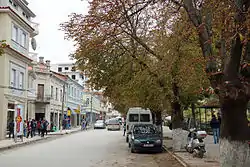 The town centre of Bilisht (2013) | |
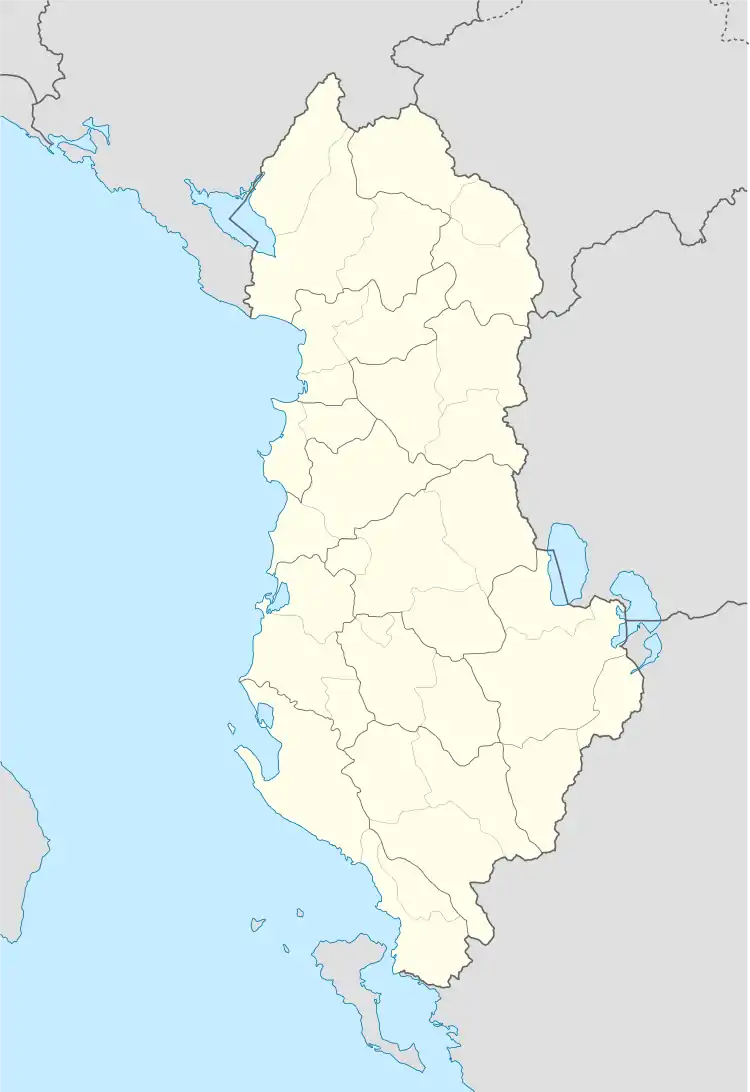 Bilisht | |
| Coordinates: 40°37′39″N 20°59′24″E | |
| Country | |
| County | Korçë |
| Municipality | Devoll |
| Elevation | 922 m (3,025 ft) |
| Population (2011) | |
| • Total | 6,250 |
| Time zone | UTC+1 (CET) |
| • Summer (DST) | UTC+2 (CEST) |
| Postal Code | 7006 |
| Area Code | (0)811 |
Geography
The town of Bilisht is the most southeastern city of Albania. It is located to the east of the Devoll Valley, about 880-970m above sea level in a hilly relief that stretches from the Devoll River bed to Kokogllava hill over the city and covers an area of 1.4km2. With average altitude 925 m above sea level Bilisht is the second highest city in Albania after Ersekë (1020m above sea level).
The city has a very favorable geographic position as it passes through the motorway link connecting Albania with Greece via the Kapshticë customs that is 7 km east of it. In the north the town is bordered by Bitinckë (3 km east of it), east bounded by the hills of Kokogllava (1140m above sea level), Stranra (1280m above sea level), Sellcë (an early residence near Bilisht) and Vërnik, (5 km east), south is bordered by Vishoçicë (3 km south), while west is bordered by Devoll River and villages like Poloskë (4 km), Kuç (3 km), Baban (5.5 km ) and Hoçisht (6.5 km). Bilisht has a population of about 12,000 and is the capital of the Municipality of Devoll.
The tyrbe (tomb) of the Muslim Sufi saint Qazim Baba is located in Bilisht.[4]
Climate
The climate in Bilisht is Mediterranean transient, but with remarkable continental influence. The high sea level (930m), as well as the distance from the sea, makes the summer in Bilisht to be warm and fresh, with a cold and snowy winter, as well as with the fall of fresh autumn.
The average annual temperature is 9.9 degrees. The hottest month of the year is July with an average of 19.5 degrees C, where the highest and lowest temperatures range from 14 degrees in the night and 26.6 degrees during the day. The coldest month is January with an average of 0.2 degrees, with average temperatures ranging from -3.6 degrees at night and 4.1 degrees during the day. The maximum temperature was reached in July 1988 (39 degrees) while the minimum was reached in January 2012 (-20 degrees). The annual temperature range is 19.3 degrees.
The precipitation in Bilisht is lower than in other cities of Albania as a result of the strong continental and mountain ranges that surround this area. The average annual rainfall is 780mm. The largest amount of rainfall is reached in the spring and fall months: November (100mm) and October (89mm). Most of the precipitation is in May where on average there are 15 days of rainfall and 16 days of dryness. The dryest months are August (39mm) and July (40mm). The highest number of dry days is August, where on average there are 23 dry days and 8 days of rainfall In the second half of autumn snowfall begins which falls until April. During the winter the largest amount of snowfall falls, mainly in January (4 days on average) and February (5 days on average). Usually snow precipitation may be present even in the spring months.
The frosts in Bilisht are present during the 8 months of the year, the month with the highest number of frosts is January (19 days), while the month with fewer days with frost is May (0.1 days) and October (1.3 days)
The wind at Bilisht is mainly blowing from the west and the north, the month with the highest wind speed is February with March (9 km / h), while the lowest speed is August at 6 km / h. The largest windmill is March, where the average wind speed averages 5 km / h over the course of 15 days, while the less windy month is October, where the wind averaged 5 km / h in 7 days.
Sunny days and sunset: The most sunny month is August, where on average there are 13 sunny days and 17 days partly cloudy or wintry, while the waning month is May where on average 25 days are cloudy or partly cloudy and 6 days with Sun.
History
A fortified location dating from the early Iron Age exists nearby Bilisht.[5]
Bilisht was part of the Ottoman Empire for several centuries. Muslims in the kaza (district) of Bilisht owned tenet farms (baștina) in the late 16th century.[6] Bilisht became an important centre for the Sufi Halveti order[7] and maintained two or three tekkes in the town that were reliant on its tekke in Ohrid.[8] During the Great Eastern Crisis, the Treaty of San Stefano nearly placed Albanian areas such as Bilisht in a proposed large Bulgarian state.[9] Shortly thereafter it was superseded by the Treaty of Berlin that left the town and its surrounding area in the Ottoman Empire. In the late Ottoman period, the nahiya (sub-district) of Bilisht was a centre of revolutionary activity for Albanian and Aromanian cheta groups, whom collectively numbered some 150-200 individuals.[10] Until the early twentieth century, Bilisht experienced population growth from the surrounding rural area, as it was a centre for artisan activities and trade located on important transport lines.[11] It also made the town vulnerable in times of crisis to robberies and war.[11]
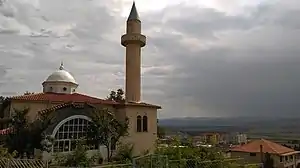
Following the Balkan Wars (1912-1913), Bilisht became part of Albania. Some Muslim Albanian villages on the Greek side of the border had Bilisht as their market town until their inhabitants were sent to Turkey during the Greco-Turkish exchange of populations (1923),[12] based on religious criteria. Due to the Albanian census of 1923, the urban status of Bilisht was recognised.[3] During the interwar period a tekke of the Rifa`i Sufi Order existed in Bilisht[13] and part of the surrounding Muslim rural population emigrated to Australia.[14] Bilisht was also the centre of the Bilisht district.[3]
In the 1960s, the area around Bilisht and neighboring Korçë had the highest densities of population in mountainous districts within the country (500 metres and above).[15] During the early 1990s, Christianity and later Islam were revived in Albania.[16] As such in Bilisht, the Orthodox church of Saint Veneranda (Shën e Premte) was rebuilt in 1992 followed by a new mosque in 1995.[16] The town in post communist Albania has also been a recipient of in-migration by a small number of people from other parts of the country, due to pre-existing family connections.[17] New shops have opened in Bilisht[18] and it has been one of a number of towns in the wider area that has attracted investment.[19]
Demographics
Ottoman geographer Hadji Khalfa (1609-1657) wrote that during the mid seventeenth century the nahiya (sub-district) of Bilisht was populated by a mixed Albanian and Bulgarian population and the Christian element was declining due to local disturbances and inhabitants converting to Islam.[20] In the early nineteenth century, the ethnic border between Albanians and the neighbouring Slavic (Bulgarian) population ran close and to the east of Bilisht.[20] Between 1805–1807, the British traveller William Martin Leake passed through the area, referred to the ethnic border and stated that the people of Bilisht spoke Albanian.[20]
According to Georgi Trajchev in 1929, Bilisht in 1912-1913 was recorded as having 20 households and 106 inhabitants with the settlement described as a Bulgarian village.[21]
During the 1980s, the population was 5600.[3] In post-communist Albania, Bilisht contains a mixed population of Muslims and Orthodox Christians.[12] In 1995, it had 8000 inhabitants[12] and 7000 in 2001.[22] Apart from the village of Vërnik, all other settlements of the Devoll region including Bilisht are populated by an Albanian speaking population.[12] A Romani community also exists in the town that settled in Bilisht during the 17th century.[23]
Governance
The municipal council for Devoll composed of 17 members is located in Bilisht.[24] In local Albanian elections of the early 2000s, a member of the Romani community was elected to the municipal council as a councilor.[25] At the 2011 Albanian local elections, the Macedonian minority succeeded in electing one councilor to the municipal council.[24] In the early 1990s, the Greek political party Omonia in Albania fielded a local candidate from Bilisht in elections, however it was later withdrawn after threats of violence.[26]
Popular culture
The town of Bilisht is the location for events in an Albanian polyphonic song Në plepat Bilishtit (The poplars of Bilisht) that commemorates male bravery, honour and family values.[27]
Gallery
 Centre of Bilisht
Centre of Bilisht Primary school "Dritëro Agolli"
Primary school "Dritëro Agolli" Elementary school "Myteza Zyko"
Elementary school "Myteza Zyko"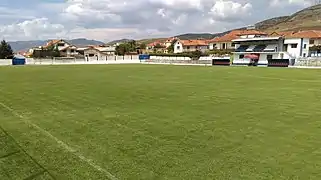 "Devolli" Stadium
"Devolli" Stadium "Çezma e Madhe" (large water fountain), erected 1914-1918
"Çezma e Madhe" (large water fountain), erected 1914-1918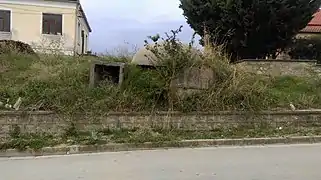 Communist era bunker
Communist era bunker Monument to local victims of communism
Monument to local victims of communism Bilisht and Orthodox Church (far right corner)
Bilisht and Orthodox Church (far right corner)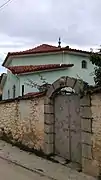 Halveti tekke
Halveti tekke Streetscape in Bilisht
Streetscape in Bilisht Houses in Bilisht
Houses in Bilisht
References
- "Law nr. 115/2014" (PDF). Archived from the original (PDF) on 2015-09-24. Retrieved 2015-06-11.
- 2011 census results Archived 2015-09-24 at the Wayback Machine
- Altmann, Franz-Lothar; Elsie, Robert (1990). Albanien im Umbruch: eine Bestandsaufnahme. Oldenbourg. p. 212. ISBN 9783486558487.
- Elsie, Robert (2000). "The Christian Saints of Albania". Balkanistica. 13 (36): 53.
- Hammond, Nicholas Geoffrey Lemprière (1994). Collected studies, Volume III. Adolf M. Hakkert. p. 6. ISBN 978-9025610517.
- Ergo, Dritan (2010). "Islam in the Albanian lands (XVth-XVIIth Century)". In Schmitt, Oliver Jens (ed.). Religion und Kultur im albanischsprachigen Südosteuropa [Religion and culture in Albanian-speaking southeastern Europe]. Frankfurt am Main: Peter Lang. p. 42. ISBN 9783631602959.
- Clayer, Nathalie (1990). L'Albanie, pays des derviches: Les ordres mystiques musulmans en Albanie à l'époque post-ottomane (1912-1967). Harrassowitz. p. 145. ISBN 9783447030885.
- Elsie, Robert (2002). Handbuch zur albanischen Volkskultur: Mythologie, Religion, Volksglaube, Sitten, Gebräuche und kulturelle Besonderheiten. Harrassowitz Verlag. p. 90. ISBN 9783447044875.
- Cuaz, Marco (1996). "Il tema dell'identità nazionalenella storiografia albanese". Passato e Presente. XIX (39): 99. "trattato russo-turco di Santo Stefano del 3 marzo 1878 che avrebbe fissato le «indiscutibili frontiere etniche bulgare», occupando i territori albanesi di Korcia, Bilisht, Pogradec, Struge, Dibër, Gostivar, Kaçanik e Kumanove."
- Georgiev, Velichko; Trifunov, Stayko (1994). История на Българите 1878-1944 в документи: Българите в Македония, Тракия и Добруджа. Prosveta. p. 476. ISBN 9789540105581.
- Vullnetari 2007, p. 21.
- De Rapper, Gilles (2012). "Blood and Seed, Trunk and Hearth: Kinship and Common Origin in southern Albania". In Hemming, Andreas; Kera, Gentiana; Pandelejmoni, Enriketa (eds.). Albania: Family, Society and Culture in the 20th century. LIT Verlag Münster. pp. 80–81. ISBN 9783643501448.
- Popovic, Alexandre (2010). "Les confreries mystiques musulmanes dans liespace albanophone (XIXe-XXe s.)". In Schmitt, Oliver Jens (ed.). Religion und Kultur im albanischsprachigen Südosteuropa [Religion and culture in Albanian-speaking southeastern Europe]. Frankfurt am Main: Peter Lang. p. 112. ISBN 9783631602959.
- Vullnetari 2007, p. 17.
- Vullnetari, Julie (September 2007). "Albanian Migration and Development: State of the art review". IMISCOE (International Migration, Integration and Social Cohesion): 75. Retrieved 14 September 2019. Cite journal requires
|journal=(help) - De Rapper, Gilles (2008). "Religion in post-communist Albania: Muslims, Christians and the concept of 'culture' (Devoll, South Albania)". Anthropological Notebooks. 14 (2): 41.
- Vullnetari 2012, pp. 115, 209.
- Sintès, Pierre (2010). La raison du mouvement: Territoires et réseaux de migrants albanais en Grèce. Karthala. p. 381. ISBN 9782811103903.
- Vullnetari 2012, p. 209.
- Gyuzelev, Boyan V. (2004). Албанци в Източните Балкани. ИМИР. p. 67. "Етническата граница между българи и албанци оставя двете български села като остров сред албанското население още вначалотона XIX в. Тогава тази граница е преминавала пò на изток, някъде в района на градчето Биглища. В 1805–1807 г. През Албания минал англичанинът Уилям Лийк. Според него границата настраната била селището Биглища, тъй като жителите му говорели албански. Всредатана XVII в. Турският географ Хаджи Калфа в своето описание на Европейска Турция обаче отбелязва, че жителите на нахия Биглища са българи и арнаути. Християнското население на тази област намалявало най-вече поради изселване в други крайща и приемане наисляма."
- Trajchev, Georgi. Български селища в днешна Албания, в: Отецъ Паисий, 15-31 юли 1929 година, стр.213.
- Vullnetari, Julie (2012). Albania on the move: Links between internal and international migration. Amsterdam University Press. p. 23. ISBN 9789089643551.
- Dalipaj, Gerda (2012). "Roma communities in Elbasan". In Hemming, Andreas; Kera, Gentiana; Pandelejmoni, Enriketa (eds.). Albania: Family, Society and Culture in the 20th century. LIT Verlag Münster. p. 132. ISBN 9783643501448.
- "List of elected councilors (2011 local elections of Albania)" (in Albanian). Central Election Commission of Albania. 2011. Archived from the original on 5 July 2015. Retrieved 10 March 2012.
- De Soto, Hermine; Beddies, Sabine; Gedeshi, Ilir (2005). Roma and Egyptians in Albania: From social exclusion to social inclusion. Washington D.C.: World Bank Publications. p. 111. ISBN 9780821361719.
- Bugajski, Janusz (2016). Ethnic Politics in Eastern Europe: A Guide to Nationality Policies, Organizations and Parties: A Guide to Nationality Policies, Organizations and Parties. Routledge. p. 72. ISBN 9781315287430.
Several other anti-Greek incidents are reported on the eve of the elections. For example, Thanasi Jorgji from the village of Bilisht, province of Korce, withdraws his candidacy after local Albanians threatened to burn down his house.
- Sugarman, Jane (1997). Engendering song: Singing and subjectivity at Prespa Albanian weddings. University of Chicago Press. p. 256. ISBN 9780226779720.
External links
- Visit Devoll Tourist Guide
- "Град Билища (исторически бележки)" , an article on the history of Bilishta, written by the priest Trpo Popovski in 1912 (in Bulgarian).

